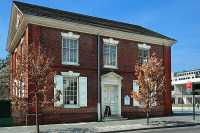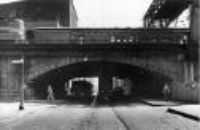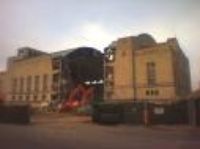Related Topics
North of Market
The term once referred to the Quaker district along Arch Street, and then to a larger district that had its heyday after the Civil War, industrialized, declined, and is now our worst urban problem area.
Quakers: The Society of Friends
According to an old Quaker joke, the Holy Trinity consists of the fatherhood of God, the brotherhood of man, and the neighborhood of Philadelphia.
Particular Sights to See:Center City
Taxi drivers tell tourists that Center City is a "shining city on a hill". During the Industrial Era, the city almost urbanized out to the county line, and then retreated. Right now, the urban center is surrounded by a semi-deserted ring of former factories.
Quakers: All Alike, All Different
Quaker doctrines emerge from the stories they tell about each other.
Tourist Walk in Olde Philadelphia
Colonial Philadelphia can be seen in a hard day's walk, if you stick to the center of town.
Favorite Reflections
 In no particular order, here are the author's own favorites.
In no particular order, here are the author's own favorites.
Arch Street: from Sixth to Second
When the large meeting house at Fourth and Arch was built, many Quakers moved their houses to the area. At that time, "North of Market" implied the Quaker region of town.
North of Market

|
| Free Quaker Meeting House |
In their 1956 book "Philadelphia Scapple", Harold Donaldson Eberlein and Mrs. Henry Cadwalader give an interesting description of the evolution of the term "North of Market". In the early days of the city, almost all of the town was South of Market Street. In fact, an early 18th Century visitor once wrote that he always brought a fowling piece when he visited Philadelphia because the duck hunting was so good at the pond located at what is now 5th and Market.
When the Quaker meeting house was built at 4th and Arch Streets, many of the more important Quaker families thought it was important to build their houses nearby. In that way, Arch Street developed the reputation of being a Quaker Street. So the original meaning of the North of Market term was the Quaker ghetto. Quaker families continued to spread West along Arch Street or nearby, and this accounts for the location of the Friends Center at 15th and Cherry and related local activities. When the Free Quaker were evicted from the meeting at 4th and Arch because of their activities during the Revolution, they built their own meeting at -- 5th and Arch.

|
| Chinese wall |
During the Civil War, a number of people made fortunes that socially upscale people over in the Rittenhouse Square area considered disreputable, so elaborate but ostracized mansions marched due North up Broad Street, where they can still be observed as stranded whales in the slums, leaders without followers. The show houses of manufacturers of shoddy war goods soon gave the meaning of parvenu to the term North of Market.
And then, the Pennsylvania Railroad ran an elevated brick structure from 30th Street to City Hall Plaza, the so-called Chinese Wall. For nearly a century this ugly looming structure on Pennsylvania Boulevard, now John Kennedy Boulevard, with its smoky engines above, and dark dripping tunnels at street level, sliced the town in half and made it very unattractive to build or to live, North of Market. The Spring Garden area had some pretty large and expensive houses, but it was cut off by the railroad trestle and has only recently started to revive. It helped a lot to tear down the Chinese Wall, but that was fifty years ago, and the area has taken a long time to recover from the earlier diversion of social flow to the South of it. And, psychologically, North of Market will take even longer to recover from the implication of -- industrial slum.

|
| center |
Meanwhile, of course, Oriental immigration settled along Arch Street at 9th to 12th Streets, and we now have our Chinatown there, complete with street signs in oriental lettering. In effect, we have a real Chinese Wall, a social one. Just what will happen to this group is unclear, since it is readily observable that they like to cluster together, unlike the East Indian immigrants, who head for the suburbs as fast as they can. Since the Chinese colony is physically blocked on all sides by the Vine Street Expressway, the Convention Center, and the Ben Franklin Bridge, it is hard to know where they will flow if the group gets much larger. The depressed Vine Street crosstown expressway makes a definitive border for downtown, and the contrast between the two sides of this expressway is striking. On one side is Camelot, and on the other side, almost nothing is being built. The future of North of Market, at the moment, is a little unclear.
Originally published: Monday, June 26, 2006; most-recently modified: Wednesday, May 29, 2019